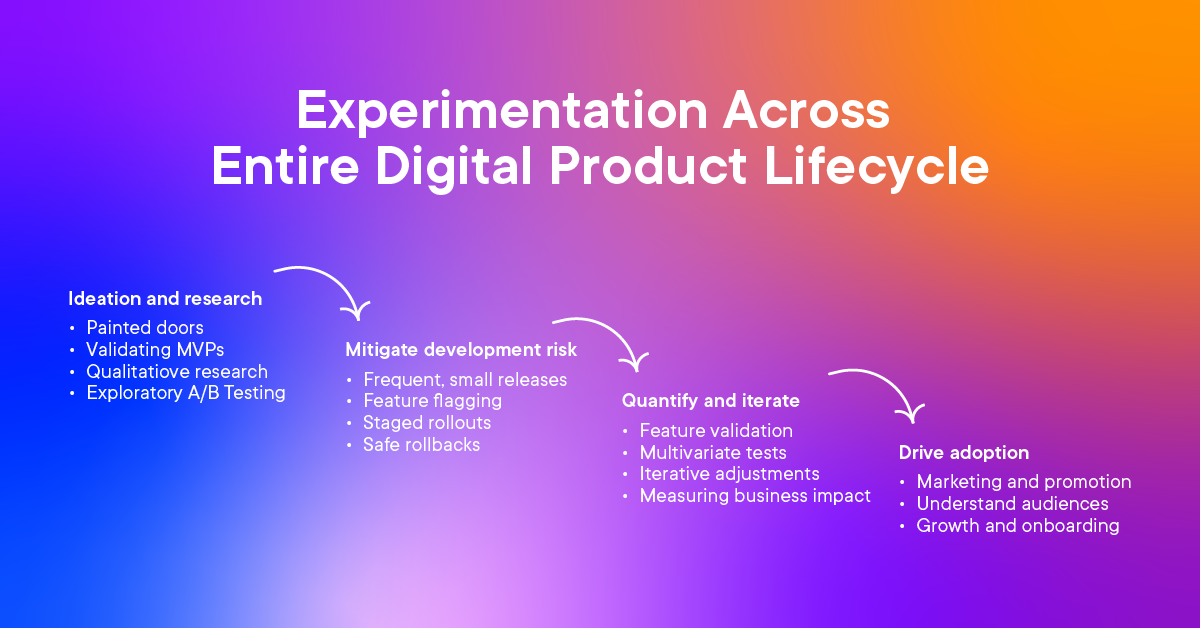Painted door test
Vad är ett painted door test?
Paint door test skapar en illusion av en funktion eller tjänst utan att du faktiskt behöver bygga den. Det är också känt som det falska dörrtestet. Det kan simulera en funktion med ett icke-funktionellt alternativ, t.ex. en klickbar knapp eller länk.
Detta tillvägagångssätt validerar om din idé är värdefull för din målgruppsinriktning. Du kan samla in data om användarnas beteende och preferenser för att fatta välgrundade beslut om genomförbarheten innan du går vidare med utvecklingen.
En del av denna testningsprocess är också ett test som kallas "fake door test". Ett test av en falsk dörr mäter intresset för en ny produkt eller funktion genom att presentera den som tillgänglig (t.ex. via en knapp eller länk). När användarna klickar får de veta att den inte är klar än. Antalet klick mäter intresset och hjälper till att avgöra om det är värt att utveckla.
Testning i fokusgrupper är nyckeln:
- Samla insikter: Förstå kundernas behov och preferenser.
- Förfina idéer: Förbättra produktkoncepten med hjälp av feedback.
Det hjälper till att skapa en bättre MVP. Vanligtvis före en produktlansering, fokusera på:
- Validera antaganden och samla in användarfeedback tidigt för att minimera riskerna.
- Testning av funktioner med genuint användarintresse, vilket ökar produktens framgångschanser.
Painted door tests är särskilt effektiva i:
-
Validering av produkt
Product Managers kan bevisa innan de utvecklar. Den här metoden visar om det finns en genuin efterfrågan på en föreslagen produktfunktion eller produkt på roadmapen. -
Prioritering av funktioner
Det finns många bra produktidéer där ute i den verkliga världen. Som produktteam kan du också få förfrågningar från interna team och kunder om att bygga nya funktioner. Prioritera vilka funktioner du ska investera i genom att identifiera vilka som har störst potential att påverka ditt företag. -
Strategi för marknadsinträde
Om du är en startup som går in på nya marknader eller nischer kan painted door tests berätta mycket om användarnas preferenser och beteenden.
Kort sagt är ett painted door test en "false feature"-metod för att testa idéer och funktioner för webbplatser/appar innan man investerar betydande kapital i att utveckla dem.

Bildkälla: Optimizely
Painted door test vs. traditionell prototyping
Namnet "Painted Door Test" kommer från analogin med att placera en painted door test mitt på en vanlig vägg. I grund och botten är det nära besläktat med användbarhetstest. Här är tanken att dörren blir en fokuspunkt som representerar en specifik funktion eller call to action som ska utvärderas. Det hjälper till att dra till sig användarnas uppmärksamhet och uppmuntra till interaktion.
Painted door test:
- Natur: Låg trohet, icke-funktionellt.
- Syfte: Mäter tidigt användarintresse med minimala investeringar och mätvärden.
- När ska man välja: Idéer i tidigt skede, begränsade resurser, snabb bedömning.
Traditionell prototypframtagning:
- Natur: Funktionell eller semifunktionell.
- Syfte: Testar detaljerad funktionalitet, användbarhet och användarupplevelse.
- När ska man välja: Förfining av funktioner, detaljerade A/B-testningar, gott om tillgängliga resurser.
Sammantaget bör du välja painted door test för snabba utvärderingar i de tidiga stadierna av din produkts experimenteringsprocess. Välj traditionell prototyping när du förfinar specifika funktioner eller utför mer detaljerade tester med gott om resurser.
Hur genomför man ett painted door test?
Till att börja med måste du definiera målet. Att bara ha ett mål är en sak, men att känna till skillnaden mellan positiva, negativa och neutrala resultat är avgörande för att minska fördomar, inklusive de från inflytelserika personer som HiPPOs.
Ett positivt resultat visar på ett positivt gensvar från publiken, vilket innebär att du kan gå vidare och bygga funktionen. Negativa resultat visar att anpassningen inte stämmer överens och att det finns behov av att ändra tillvägagångssätt. Neutrala eller ofullständiga resultat kräver en djupare analys eller justering.
Här är de återstående stegen för att komma igång med ett painted door test och leverera en framgångsrik produkt till din användarbas:
-
Identifiera
Identifiera den specifika funktion eller det koncept som du vill utvärdera och de insikter som du vill samla in. -
Välj ett element
En knapp, länk eller annan interaktiv komponent som representerar en funktion som ska utvärderas. -
Utforma
Skapa en enkel, visuellt distinkt representation av det valda elementet. Till exempel en platshållargrafik, en färgad ruta eller någon annan visuell signal som drar till sig uppmärksamhet. -
Implementera
Implementera det designade elementet på en webbsida eller i ett gränssnitt där användarna interagerar med det. Se till att det inte vilseleder användarna att tro att det är fullt funktionellt. -
Övervaka interaktioner
Låt användarna interagera med det icke-funktionella elementet på ett naturligt sätt. Var uppmärksam på klick, svävande rörelser eller försök att interagera med funktionen. -
Samla in feedback
Använd enkäter, intervjuer eller direkta observationer för att förstå användarnas förväntningar, uppfattningar och reaktioner. -
Analysera resultaten
Kontrollera mönster i användarnas beteende. Kontrollera intressenivåerna för att identifiera eventuella missuppfattningar som användarna kan ha haft om det icke-funktionella elementet. -
Iterera eller gör en strategisk förändring
Baserat på de insikter du fått kan du iterera designen eller göra en strategisk förändring om det behövs.
Fördelar med painted door test
- Kostnadseffektivt - Genom att undvika för tidig utveckling sparar du värdefulla resurser som kan läggas på funktioner med bevisad efterfrågan.
- Riskreducering - Du kan minimera risken för att investera i funktioner eller produkter som kanske inte får fäste på marknaden.
- Datadrivet besluts fattande - Du får insikter baserade på verkligt användarbeteende, vilket vägleder beslut om produktutveckling.
- Snabbt utpå marknaden - Du kan validera idéer utan långa utvecklingscykler, vilket möjliggör snabbare iterationer och anpassningar.
Exempel på painted door test
Kolla in dessa exempel på painted door test som du kan använda:
- Prenumerationstjänster - Erbjud en prenumerationsbaserad tjänst på din webbplats utan att faktiskt tillhandahålla tjänsten. Mät anmälningsfrekvens och intresse för att mäta efterfrågan.
- Feature teasers - Marknadsför kommande funktioner på din plattform och spåra användarengagemang genom klickfrekvenser eller registreringsformulär.
- Förbeställningskampanjer - Starta förbeställningskampanjer för nya produkter eller funktioner för att bedöma intresset och justera produktionen därefter.
Det sista ordet om painted door test
Painted door tests kan hjälpa dig att fatta bättre informerade beslut, minimera resursrisker och påskynda innovation.

